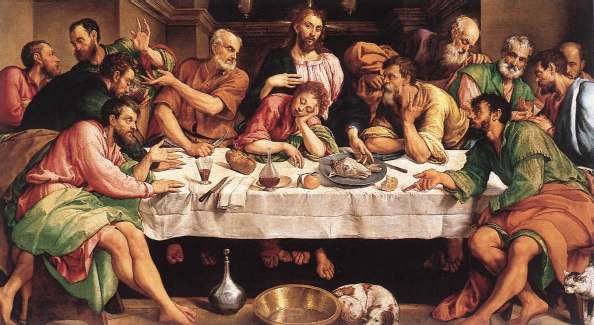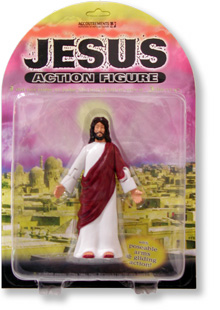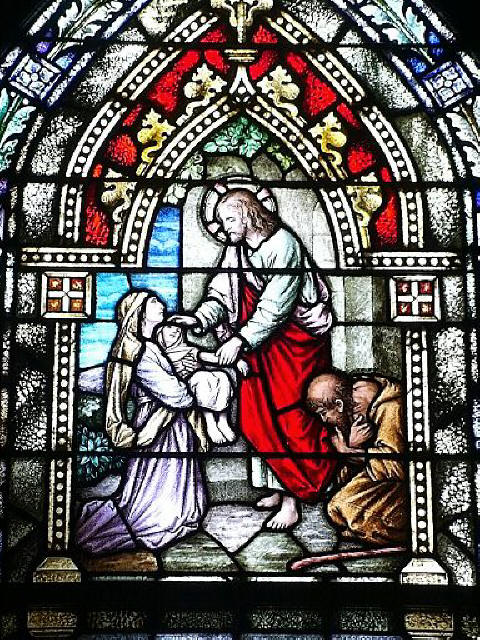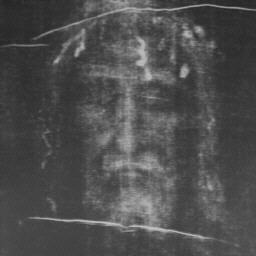|
Jesus Christ
Jesus H. Christ was born (ironically enough) around five to six years "before Christ" (B.C.) due to a scheduling mixup. Generally depicted in art as a white guy with blue eyes and dirty blonde hair, the location of Jesus' birth and his ethnicity suggest that he probably looked a lot more like Osama bin Laden than Brad Pitt. His parentage has been the subject of much controversy. His mother is generally agreed to have been a woman named Mary, and upwards of 2 billion people would make some sort of claim to the effect that his Father was Yahweh, the Jewish God (as opposed to Zeus, Durga, Allah, Jupiter, Anubis, Quetzalcoatl or Keanu Reeves).
In the Bible, Jesus was a precocious child, given to lecturing rabbis on the finer points of Talmudic law and chiding his parents for being so attached to him. A few unauthorized biographies of the "mysteriously-not-burnt-by-the-Catholics" variety, such as the Infancy Gospels of James and Thomas, relate salacious anecdotes about the prepubescent Jesus and his Bart Simpson-like antics — such as using divine powers to blind fellow children who presumed to roughhouse with His Fine Self. Don't have a cow, man! When Jesus grew to adulthood, he took up preaching as a career choice. In turn-of-the-Aeon Israel, preaching was a hot career much like computer programming in the 1990s. Everyone was doing it. Amidst a crowded field, however, Jesus stood out as an overachiever and soon people were talking. He gathered a core group of 12 groupies, who would later become known as The Apostles, and took his show on the road at age 30. Jesus' pitch was something new — he talked about God as a loving, forgiving figure, in sharp contrast to God's previous reputation as a pillar-of-salt-transforming smiter of iniquity. He also made a name for himself as a miracle-worker, enabling the blind to see and the deaf to hear, casting out demons, walking on lakes, changing water into wine and making the Statue of Liberty disappear during a prime-time special. Jesus spent a lot of time curing sick people, feeding the masses and disrupting the money-making activities at local temples. These activities did not endear him to the Jewish authorities, who began researching ways to get rid of him. Eventually they settled on the tried and true method of betrayal by a close friend, and hired Judas Iscariot, one of the Apostles, to do the job for 30 pieces of silver. In a needlessly elaborate Passover plot, Judas led authorities to the Garden of Gethsemane after supper (which would in retrospect be designated "Last"), telling them to arrest the first person he kissed. The accounts of what followed are somewhat muddled, but the general idea is this: For both political and religious reasons, the Jewish council of priests didn't want to personally execute Jesus, so they turned him over to the Romans on charges of inciting revolution.
The crucifixion went off without a hitch. Jesus was marched up to a hill, nailed to a cross and died. Or did he? The official story is that Jesus died on the cross, was tossed in a grave but not embalmed (due to the impending Passover Sabbath) and miraculously rose again in three days. Not surprisingly, this account has been the subject of much dispute after the fact. Again according to the party line, the Risen Jesus spent 40 days hanging with his Apostles, before bodily ascending into Heaven for the duration of human history. When he departed, or so the story goes, Jesus (allegedly) put Peter in charge of the Church, a fateful (alleged) decision that would lead to centuries of bad blood among the various Christian sects. About five minutes after Jesus was out of the public eye, the controversy began. It's universally accepted that Jesus was granted his surname, Christ, around this time. Christ is Greek for "Messiah," the fabled Jewish savior was foretold in the Old Testament. Prior to this time, the Jewish vision of the Messiah was a bit more conventional, involving Kingship and leading their armies to victory against the Gentiles. The early Christians usurped the whole Messianic complex and voted Most Likely to Save. After that, things got sticky. Although there are no reliable historical accounts of the first decades of Christianity, the early Christians had divided into camps based on their favorite apostles by 100 A.D. These various sects had a lot of strange ideas, such as the Gnostics, who claimed that Jesus never died on the cross at all. When the followers of the peaceful and loving Jesus realized that disagreements existed, they naturally began viciously attacking each other. A period of internecine warfare commenced, with the followers of the Peter Tradition coming out victorious. The surviving entity, known as the Roman Catholic Church, proceeded to spend a couple centuries systematically destroying all opposition, only to be completely screwed a thousand years later when Martin Luther nailed a laundry list of complaints to a church door.
According to these theories, Jesus was taken down from the cross still alive and nursed back to health. He then sired a child with Mary Magdalene, who took the kid to France and raised him there. The Knights Templar formed to protect this secret, codenamed "Holy Grail," and the descendants of Jesus eventually became a line of French kings known as the Merovingians (which would then lead to a neat little inside joke in The Matrix Reloaded). According to this theory, which is far more convoluted and labyrinthine than the above paragraph might suggest, you can actually meet the living descendent of Jesus today. Unfortunately for residents of George W. Bush's America, he's a Frenchman — a guy by the name of Pierre Plantard, who runs a not-so-secret-anymore society and generally sits around quietly waiting for the world to acknowledge him.
All this talk of a Second Coming has naturally led to many mentally unbalanced people to assume they are it, including (but not limited to) David Koresh, Sun Myung Moon, Marshall Applewhite, The Beatles and John Ashcroft. To date, none of these figures have successfully walked on water or returned from the dead, so the search, such as it is, goes on.
Timeline
|

 The location of his birth is inconsistently reported, even in the
The location of his birth is inconsistently reported, even in the  The Roman governor Pontius Pilate was extremely suspicious of this development, since the Jews did not suffer occupation gracefully and there were plots on every street corner. Suspecting he was being set up as the fall guy, Pilate tried to make Jesus somebody else's problem, but nobody else was interested. Under heavy pressure from the council, Pilate eventually waffled his way through the dilemma by essentially condemning Jesus to death by
The Roman governor Pontius Pilate was extremely suspicious of this development, since the Jews did not suffer occupation gracefully and there were plots on every street corner. Suspecting he was being set up as the fall guy, Pilate tried to make Jesus somebody else's problem, but nobody else was interested. Under heavy pressure from the council, Pilate eventually waffled his way through the dilemma by essentially condemning Jesus to death by  The
The  As for Jesus himself, word has it that there's a Second Coming in the works, which would in all likelihood be the precursor to the
As for Jesus himself, word has it that there's a Second Coming in the works, which would in all likelihood be the precursor to the